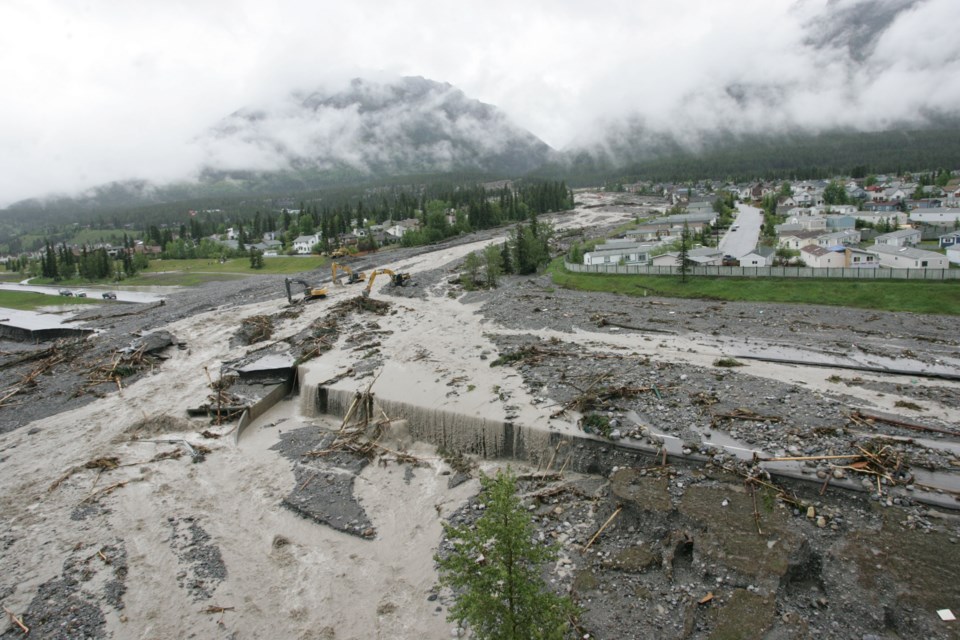CANMORE – More than six years after flooding in mountain creeks affected the community of Canmore, the long-term mitigation project for Cougar Creek – a $48 million debris retention structure – may finally be moving forward.
The major infrastructure project was initially approved by the Natural Resources Conservation Board (NRCB) in November 2018, however the design was changed to reduce costs and speed up construction. The changes, however, had to be resubmitted to the regulator for approval.
In a press release, the NRCB announced its official go ahead last Wednesday (Oct. 23) after the Town of Canmore submitted its revised application at the beginning of September.
“The Natural Resources Conservation Board has found the Town of Canmore’s revised Cougar Creek debris flood retention structure application to be in the public interest,” reads a statement from the regulator.
“The NRCB concluded that the structure will protect public safety, property, and infrastructure and has no unacceptable environmental impacts.”
According to Felix Camire, the Town of Canmore’s project manager, the notice of approval is good, though a few steps remain to be taken.
“The next step is the decision has to go to the government to be signed off on, so the NRCB they provide a decision, but it’s got to go to government to be signed off,” said Camire.
“Then we need to get our actual permits. So our next step is to actually get our land disposition, because we’re building within the wildlife park, as well as the Water Act approval. Those are the two permits/approvals that we need, to be able to construct, operate and maintain the structure.”
The changes made to the design by the Town of Canmore were for the access road, spillway and the dam structure itself. During an update to council in January of this year, administration revealed it was recommending making these changes to the original plan because the project otherwise exceeded the budget.
As a result, the NRCB was required to either amend its decision or issue an addendum. Camire told council in January that the new plan could reduce construction time by six to 12 months, as well as be significantly cheaper to build. In its most recent press release, the NRCB said that application has been reviewed and it “remains satisfied” with the project.
“The NRCB originally issued a decision on Nov. 15, 2018, determining that the application was in the public interest. However, prior to authorization through order in council, the Town advised that it was revising the project’s design to shorten the construction schedule and reduce costs. The NRCB suspended its decision and requested that the Town file a revised application,” the release stated.
“The Town filed its revised application on Sept. 6, 2019, describing impacts on social, economic, and environmental indicators stemming from design changes to the dam structure, the spillway, and the access road. The NRCB has now reviewed the revised application and remains satisfied that the project is in the public interest having regard for the social, economic, and environmental effects of the project.”
Camire said without the NRCB approval, the project wouldn’t be able to move forward.
“The project couldn’t go ahead, or we couldn’t get land disposition, or the water act, so that’s the main approval that was required to be able to move forward with the project,” said Camire.
“The land disposition – we’ve been working on this with Alberta Parks for a while now. The legal survey has been done and we are working through the details on the disposition – so it’s not something we’re starting now, it’s been in the process for a while now. And then the Water Act, it shouldn’t be an issue… people who will be reviewing the water act, they know the project practically inside and out, so we don’t see any issues with that.”
In its addendum, the NRCB said it did not see in the Town’s revised application any significant effects on land use.
“The board finds that the overall change to the project footprint (moving the spillway onto the east abutment and removal of land for the original access road from the west abutment) has no effect on land use. The board finds that the project remains a relatively small footprint to accomplish the key objectives of debris flood mitigation,” the decision said.
“Based on the evidence provided by the Town … the board finds that the revised project design does not change the board’s conclusions or conditions in board decision NR 2018-01 with respect to land use and management within the boundaries of the Town and the Bow Valley Wildland Provincial Park.”
Camire said the debris retention structure, which was proposed in 2014 – a year after the floods hit Canmore – will see construction begin as early as possible.
“We’re aiming for construction next year, when we’ll be able to start exactly I can’t tell you just because I don’t know, but we’re pushing for as early as we can next year, 2020, to start construction,” he said.
The debris retention structure, which is budgeted at $48 million, $44 million of which has been provided by both federal and provincial governments, is proposed to be 30-metres tall and is designed to stop 650,000 cubic metres of water and sediment.






